Ancient Chinese Charms and Coins
Introduction to Chinese Charms
China was one of the first countries in the world to use metal coinage and its ancient coin history can be traced back well over two thousand years. In addition to official coinage, China also has a long history of producing "coin-like" charms, amulets and talismans.

with Immortal, Tortoise
and Crane
Cast throughout the centuries, these ancient charms,
informally referred to by the Chinese as "ya sheng coins" (压胜钱),
"flower coins" (huaqian 花钱) or "play coins" (wanqian 玩钱), were not used as money but rather to suppress evil
spirits, bring "good luck", "good fortune" and to avert
misfortune.
The Chinese also produced other "coin-like" pieces such as "horse coins" (马钱), depicting famous historical horses, which were used for games and as gambling tokens. Other metal coin-shaped pieces traditionally included by collectors in the category of charms are the chess pieces used in Chinese chess also known as "xiangqi (象棋) or "elephant" chess.
For the most part, all these old charms, horse coins and chess pieces were privately cast and their quantities and dates are almost impossible to determine. Nevertheless, they serve as important cultural artifacts from the life of the common Chinese throughout the centuries.
Private Casting of Charms and Coins
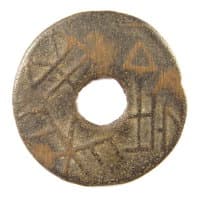
At the time, each of the warring states had its own form of currency which included coins, such as the example on the left, as well as other distinctive forms of money such as knives and spades.
For examples of the spade or shovel money, please see spade charms. Central governments usually attempt to monopolize the issuing of currency in order to minimize financial chaos. In so doing, private minting is usually prohibited.
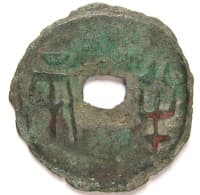
China continued to have individuals casting private money as evidenced by the need for Empress Lu Hou of the Western Han (206 BC - 24 AD) to issue an edict in 186 BC prohibiting citizens from issuing private currency. However, in the year 175 BC, Emperor Wen abolished this prohibition and allowed the people to issue private currency. One of his favorite officials, Deng Tong, issued currency said to have "prevailed throughout the realm".
Although subsequent dynasties time and again attempted to prohibit the private issuance of money, private coinage still took place. The primary purpose of the private coinage was, of course, to make a profit. But, a good part of the casting was because the Chinese believe that coin-like charms can avert misfortune, can be used to celebrate happy events, and can control evil. It is these types of "coins" we refer to as charms or amulets.
Reasons for the Emergence of Chinese Charms
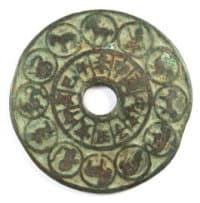
This was also a time when there began a separation between manual labor and intellectual labor resulting in, for example, diviners who could divine the ominous, auspicious, calamity and happiness for the tribal chiefs, as well as shamans who could drive away the evil spirits and cure diseases.
This was also the incipient period for the appearance of states with kings who received the "mandate from heaven" and ruled citizens.
By the time of the Han Dynasty, Confucianism and Taoism (Daoism) were already prevalent and Buddhism was arriving which caused the people to feel that the power of heavenly spirits was something that could not be violated. Only by following the intentions of heaven could one enjoy constant good luck and avoid calamity.
For these reasons, people wished that their lives would be happy,long-lasting, and wealthy with many sons and grandsons. After death, they hoped to quickly ascend to the world of the immortals or reincarnate as a person. People began to worship heaven, the Buddha, and the immortals by means of memorials and ceremonies, prayers,sorcery, divination and eulogy.
Because the people were accustomed to the forms of coinage in circulation at the time and because they were convenient to carry, charms and amulets began to appear in similar forms.
Early Precursors of Chinese Charms
While it is not known for sure when "good luck" charms first appeared in China, their precursors can be traced back to at least the 7th - 4th century BC. There are examples of "three character knives" of the State of Qi with the character ji (吉) meaning auspicious.
The last years of the Warring States period saw the production of a type of round coin (一刀) that had the same character 吉. This character 吉 is generally believed to be derived from a character on ancient oracle bones meaning to pray for luck.
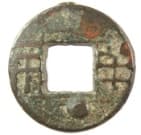
big star below
square hole
Some of the ban liang (pan liang) coins of the following Western Han (206 BC - 8 AD) have horizontal and vertical lines and raised dots which could be explained as representing the stars, moon and sun.
A detailed discussion of these ancient Chinese banliang coins and their images can be found at Chinese Coins and Emergence of Chinese Charms.
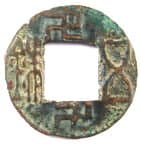
with swastika
Many of these coins have "auspicious symbols" including stars and star constellations, the moon, the sun, swords, auspicious animals such as the turtle and snake, etc. One such example of this type of auspicious wuzhu coin has swastikas both above and below the square hole as is shown here.
Please see the emergence of Chinese charms for more examples of these very old Chinese charms. Please also see ancient Chinese charm symbols: star, moon, cloud and dragon for a theory relating these symbols to the fundamental belief of the ancient Chinese in Yin Yang and the Five Elements.

charms of the
Han Dynasty
Many scholars now believe that the first true charms and amulets appeared
during the Han Dynasty and archaeological evidence seems to bear this out.
Some of these early charms were meant to be worn.
The charm at the left, for example, is considered by many scholars to be among the very first true charms of the Han Dynasty and is discussed in detail at Chinese Pendant Charms.
Evolution, Development and History of Chinese Charms
The major evolution and development of Chinese charms occurred during the period from the Six Dynasties (220 - 586 AD) to the Yuan Dynasty (1271 - 1368 AD). During this time, wordings on charms to wish for "happiness" and "longevity" became more common and widespread. Charms with Buddhist and Taoist sayings also appeared as did charms for marriage. These charms were now being made from such various materials as gold, silver, bronze, iron, tin,lead, jade, porcelain and paper. The styles of calligraphy also evolved from the Han script to the regular style, grass style, seal style and "Taoist magic symbol" style.
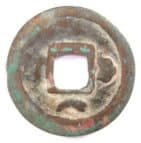
auspicious cloud
and moon
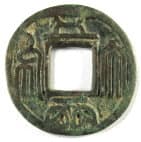
charm
(obverse side)

snake, tortoise, Big Dipper,
and double-edged sword
As an example, please see this wu xing da bu
(五行大布) charm which, on the reverse side, has the snake above, the tortoise below, the double-edged sword to the right and the seven-star (Big
Dipper) constellation to the left of the square hole.
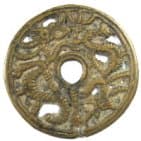
two dragons
It was also during this time that charms with auspicious sayings on the obverse side, such as chang ming fu gui (长命富贵), were making their appearance. The reverse side of the charms showed various pictures reflecting the Taoist (Daoist) influences, the bagua, and the twelve animals of the zodiac.
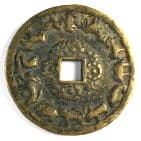
Charms with inscriptions such as fu de chang shou (福德长寿) and qian qiu wan sui (千秋万岁) were first cast at the end of the Northern Dynasties and then continued right through the Liao, Jin and Yuan Dynasties. Pieces used in table games such as the horse game, chess, and the drinker's wager game also made their appearance during this period.
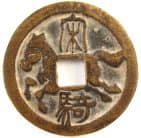
The Song Dynasty (960 -1279 AD) saw a large number of charms cast. The quality of horse coins used as pieces in a board game and as gambling tokens reached its peak during this time.
If you have an interest in these pieces, please see my page devoted to ancient Chinese horse coins.
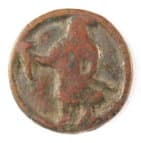
piece displaying soldier
holding weapon
Besides the board game played with horse coins, the Chinese also developed their own version of chess which we call "Chinese chess".
The Chinese call it "elephant chess" (xiangqi) and the game includes elephants, cannons and even a river. To the left is an old Chinese chess piece.
For more images and information on old Chinese chess pieces please see ancient Chinese chess (xiangqi) pieces.
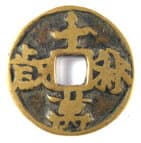
(Qian Qiu Wan Sui)
The Jin Dynasty (1115 - 1234 AD) saw the emergence of charms with some special characteristics. This was the result of the merging of the cultural arts of a plateau nationality with the ceremonies and legal customs of the Han nationality, along with styles of charms that had developed since the Song Dynasty. The Chinese are very good in using symbolism, allusions, suggestions, and homonyms to describe their customs and, during this period, drew on the experiences of the national minority of the Jin Dynasty to do so. For example, they used the symbol of the dragon to represent the emperor and the phoenix to represent the empress. Tigers and lions represented the ministers of government. The pine tree and the crane symbolized longevity. The jujube fruit symbolized "morning or early" because of a shared pronunciation (zao). Similarly, a "chicken" represented "lucky" because both characters are pronounced ji.
The Ming (1368 - 1644 AD) and Qing (Ch'ing) (1644 - 1911 AD) dynasties saw the production of a very large quantity of charms with inscriptions of good fortune and celebration. Most of the charms and amulets you will see on my website are from this period so please be sure to see my page on auspicious inscriptions -- good fortune, wealth, longevity, honor, sons and official rank.
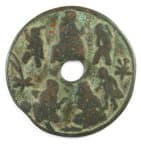
showing children
Ming and Qing (Ch'ing) Dynasty charms further expanded the repertoire of visual puns to convey a hidden meaning. For example, it may seen strange to the uninitiated to frequently find depictions of bats on the charms of this period until one is informed that the character for a bat (蝠) has exactly the same pronunciation as the character for "happiness" (福). On many charms, these bats are shown upside down. This is because the Chinese word for "upside down" (倒) is pronounced exactly the same as "to have arrived" (到). A person seeing a picture of an upside-down bat on a charm might say "the bat is upside-down" but anyone listening would just as easily hear this as "happiness has arrived" which, of course, is a good omen. For more detailed information on this topic please see the hidden meaning of Chinese charm symbols.
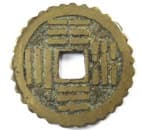
with trigrams

Tokens, such as the ones at the left, also began to appear during this period, particularly in Jiangsu Province. For a discussion of the metal tokens please visit Chinese Tokens. The bamboo tallies are discussed at Bamboo Tallies.
Chinese Charms of Different Shapes
Most Chinese charms are similar to old Chinese coins in that they are round with either a square or round hole in the center.
However, old Chinese charms can take on different shapes according to their intended use.
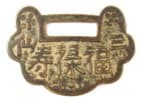
For examples of old Chinese lock charms please see Ancient Chinese Lock Charms.

Fish charms symbolize perseverance in overcoming the barriers a person must pass through in life.
Images and historical information concerning old Chinese fish charms can be seen at Ancient Chinese Fish Charms.
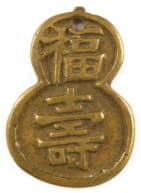
The gourd is an important symbol in ancient Chinese myths. Hundun was a god of primordal substance and referred to as the Cosmic Gourd.
In Daoism (Taoism), the gourd represented heaven and earth. The gourd also symboized self-containment and self-sufficiency, and played an important role in alchemy.
The gourd was a symbol of one of the "Eight Immortals" and a "magic gourd" was described in the famous Ming dynasty novel "Journey to the West".
For a very detailed discussion of old Chinese gourd charms please see Ancient Chinese Gourd Charms.
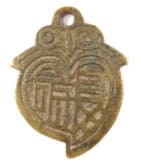
Charms and amulets, as well as swords and arrows, that were made of peach wood also provided protection from evil spirits.
For a discussion of old Chinese peach charms and stories concerning the peach and the Queen Mother of the West and the Three Immortals, please see Ancient Chinese Peach Charms.
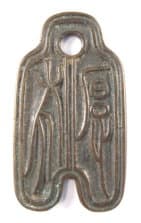
This shovel-shaped form of money was derived from the farming instrument used in farming.
Spade money was abolished during the Qin dynasty (221 - 206 BC) but then briefly revived during the Xin dynasty (9 - 23 AD).
For images of old Chinese spade charms and a brief history of their evolution from ancient Chinese spade money please see Chinese Charms -- Spade Charms.
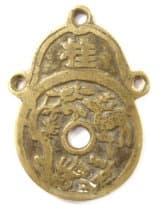
meant to be worn
It was meant to be a dress ornament worn on a person as a pendant on a necklace, a broach, hung from the waist, or it could be hung from a house rafter or other location.
Pendant charms are thought to be one of the first forms of charms and amulets to have appeared in China and can be currently dated back to the Han dynasty (206 BC - 220 AD).
There are a large number of varieties which include many different symbols and inscriptions.
To see many examples of this type of charm with detailed explanations of their meaning, please visit Ancient Chinese Pendant Charms.
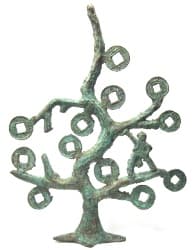
When a person shakes a money tree, coins will fall from its branches to the ground.
Very ornate "money trees" have been discovered in ancient Chinese tombs dating back to the Han Dynasty.
These trees that magically produce coins instead of leaves are believed to help guide the deceased to heaven and provide financial support.
The Chinese also believe that a "money tree" can bring wealth and good fortune to the living.
An interesting example of a Chinese "money tree" which "grows" ancient Chinese "coins", even predating its own creation, is discussed at Chinese Money Trees.
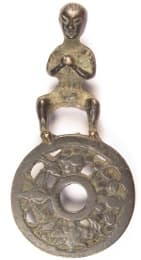
boy on top
The "ideal" Chinese family was considered to have 5 sons and 2 daughters.
A charm with a boy on top reflecting the Chinese desire for many sons can be seen at Chinese Boy Charms.
This website includes many articles on ancient Chinese coins and charms.
You may find the "Chinese Coin Guides" and the "Chinese Charm Guides" listed below to be helpful.
Also, clicking on the menu (three horizontal lines) at the top of this page will take you to various articles on old Chinese coins, charms, horse coins, chess pieces (xiangqi) and paper money, as well as extensive information on old Korean coins.
